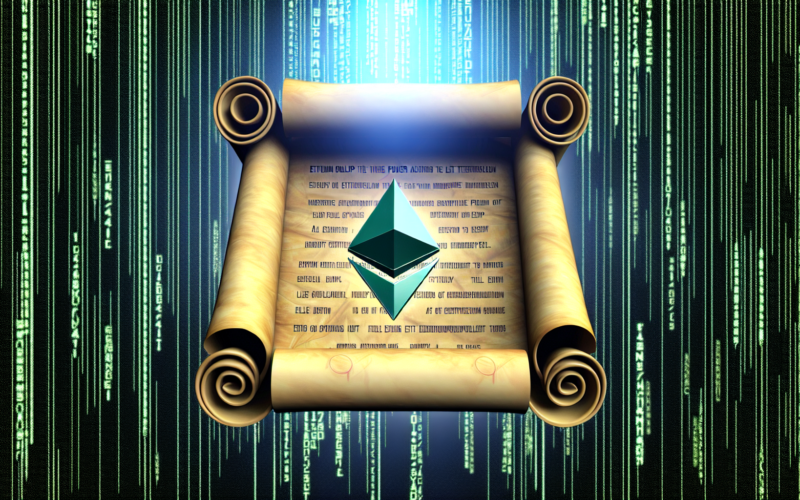Scroll reaches a key decentralization milestone, allowing independent user exits and improving transparency. Discover what this means! 🌐 #Ethereum #Blockchain #Decentralization
- Introduction: Why Scroll Matters in the Ethereum Ecosystem
- The Evolution of Ethereum Layer 2 Solutions
- Main Insights on Scroll’s Decentralization Milestone
- Challenges Facing Scroll and Similar Solutions
- Future Outlook: What Lies Ahead for Scroll
- Final Reflections on Scroll’s Decentralization Journey
Introduction: Why Scroll Matters in the Ethereum Ecosystem
In the rapidly evolving landscape of blockchain technology, Scroll has emerged as a formidable player, challenging the status quo of Ethereum Layer 2 solutions. Recently, Scroll announced a significant milestone by reaching “Stage 1” decentralization, positioning itself as a pioneer in the realm of zero-knowledge proof-based systems. This advancement allows users to exit transactions independently, eliminating the need for a centralized operator—a crucial step towards enhancing user autonomy and security. This article delves into the intricacies of Scroll’s breakthrough, its implications for the broader Ethereum ecosystem, and what this means for the future of decentralized finance (DeFi).
The Evolution of Ethereum Layer 2 Solutions
Ethereum, despite its widespread adoption and robust smart contract functionality, has long struggled with scalability issues. The rise of Layer 2 solutions was a direct response to these limitations, aiming to increase transaction throughput without compromising Ethereum’s security and decentralization. Initially, Layer 2 solutions relied heavily on centralized components, which, while effective in improving speed and cost, inherently contradicted the decentralized ethos of blockchain.
Scroll, with its focus on zero-knowledge proofs, represents a significant departure from traditional methods. By enabling transactions without a central operator, Scroll not only addresses scalability but also enhances security and fairness—a critical evolution in the Layer 2 narrative. This section explores the historical context and technological advancements that paved the way for Scroll’s innovation.
Main Insights on Scroll’s Decentralization Milestone
The Role of Zero-Knowledge Proofs in Scroll’s Architecture
Zero-knowledge proofs (ZKPs) are a cornerstone of Scroll’s architecture, allowing users to validate transactions without revealing the underlying data. This ensures privacy and security, which are paramount in financial transactions. By leveraging ZKPs, Scroll can maintain high throughput while minimizing the risk of censorship—a common pitfall in centralized systems.
Scroll’s Path to Decentralization: From Stage 0 to Stage 1
The journey to decentralization is typically marked by several stages. Scroll’s progression from Stage 0, where full control resides with the developer team, to Stage 1, signifies a shift towards smart contract governance with oversight from a safety council. This evolution is crucial as it lays the groundwork for Stage 2, where the system operates entirely on code with no central authority, offering users even greater independence.
The Impact of Scroll’s Euclid Upgrade
The Euclid upgrade is a pivotal development in Scroll’s roadmap, introducing mechanisms that ensure system resilience even if primary operators fail or act maliciously. By empowering users to post transactions independently, Scroll mitigates the risk of censorship and downtime, thus enhancing the overall reliability of the platform.
OpenVM: Breaking Down Complex Transactions
One of Scroll’s significant innovations is the development of OpenVM, a tool designed to decompose large transactions into smaller, manageable proofs. This not only prevents system disruption but also ensures that all transactions, regardless of size, can be processed efficiently—a critical feature for maintaining scalability and performance in a decentralized network.
Challenges Facing Scroll and Similar Solutions
While Scroll’s advancements are commendable, they are not without challenges. The transition to a fully decentralized system presents technical and governance hurdles. For instance, achieving consensus in a decentralized network requires robust mechanisms to prevent malicious actors from exploiting vulnerabilities. Moreover, the reliance on a Security Council, though a step towards decentralization, still introduces an element of centralization, which could be a point of contention among purists.
Additionally, the competitive landscape of Ethereum Layer 2 solutions is fierce, with projects like zkSync Era and Polygon zkEVM already establishing a foothold. Scroll must navigate these challenges while continuously innovating to maintain its competitive edge.
Future Outlook: What Lies Ahead for Scroll
Looking forward, Scroll’s path to Stage 2 decentralization will be closely watched by the blockchain community. This stage promises to limit the influence of any single entity, including the Security Council, thereby aligning more closely with the ideals of decentralization. Furthermore, as the DeFi space grows, the demand for scalable and secure Layer 2 solutions will only increase, presenting Scroll with opportunities to expand its influence.
Final Reflections on Scroll’s Decentralization Journey
Scroll’s achievement of Stage 1 decentralization marks a significant milestone not only for the project but for the broader Ethereum ecosystem. By empowering users with greater autonomy and enhancing security through zero-knowledge proofs, Scroll is paving the way for a more decentralized and equitable blockchain landscape. As the project continues to evolve, it serves as a testament to the potential of innovative thinking in overcoming the challenges of scalability and centralization. For stakeholders and users alike, Scroll’s journey offers valuable insights into the future of blockchain technology and its capacity to transform industries.











